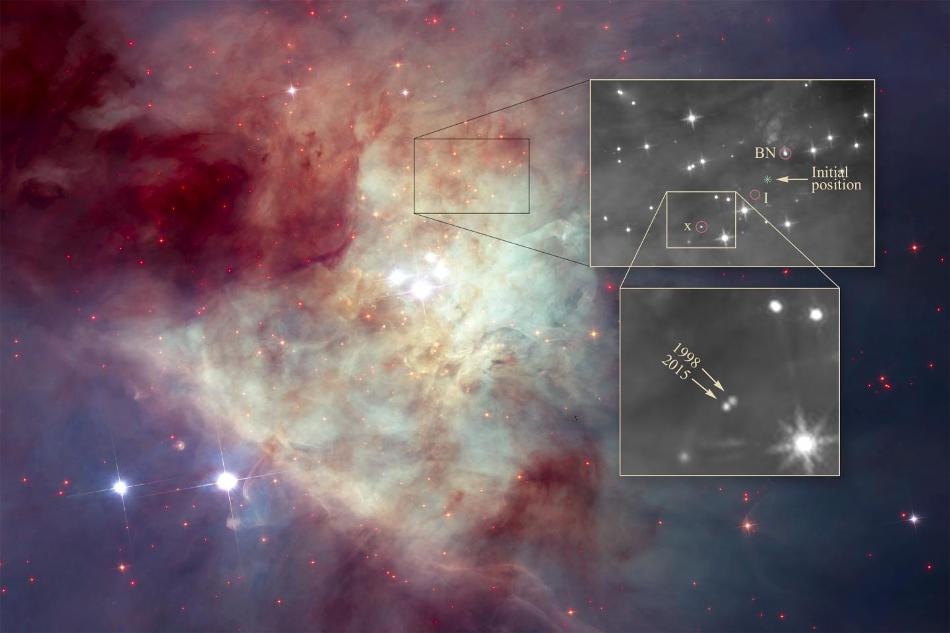Mar 31 2017
A remarkable new discovery using NASA's Hubble Space Telescope reveals three stars that now hold the record as the youngest-known examples of a super-fast-flying breed. "Until these observations, only a few -- but older -- examples of such rapidly-moving stars had been found with origins traceable back to the volatile systems that likely ejected them," said lead researcher Kevin Luhman of Penn State University. "The new Hubble observations provide very strong evidence that these three stars were ejected from an unstable multi-star system." The new discovery is published in this month's Astrophysical Journal Letters.
 (Credit: NASA, ESA, K. Luhman (Penn State University), and M. Robberto (STScI))
(Credit: NASA, ESA, K. Luhman (Penn State University), and M. Robberto (STScI))
"Based on infrared images, these three stars appear to be only a few hundred thousand years old -- young enough to have disks of material left over from their formation," Luhman said. During the mid 1400s, these three young stars likely were in a gravitational battle with each other that ended when the system exploded, ejecting its stars at high speeds in different directions.
Two of the three stars were discovered during the past few decades -- hundreds of years after they were catapulted out of their original unstable system -- but only after infrared and radio observations became advanced enough to penetrate the thick dust inside the Milky Way's Orion Nebula. These earlier observations showed that the two stars were traveling at high speed in opposite directions from each other.
Previously, astronomers had traced the paths of the two oppositely speeding stars, finding that they had been in the same location 540 years before. This discovery suggested they were part of a now-defunct multiple-star system in the Orion Nebula. But the duo's combined energy propelling them outward didn't add up. The previous researchers calculated that the energy of at least one other star was needed to blast itself away and also the two oppositely speeding stars.
The astronomers led by Luhman followed the path of the newly discovered star, and found that it traced back to the same location where the two previously known stars were located 540 years ago. The speeding trio are in a small region of young stars called the Kleinmann-Low Nebula, near the center of the vast Orion Nebula complex, 1,300 light-years from Earth. All three stars are flying extremely fast on their way out of the Kleinmann-Low Nebula, up to nearly 30 times faster than most of the nebula's other stars.
Luhman stumbled across the third speedy star, called "source x," while he was hunting for free-floating planets in the Orion Nebula as a member of an international team led by Massimo Robberto of the Space Telescope Science Institute in Baltimore, Maryland. The team used the near-infrared vision of Hubble's Wide Field Camera 3 to conduct the survey. "Very few examples of such stars have been observed, especially in very young clusters," Luhman said, even though computer simulations had led astronomers to predict that these gravitational tug-of-wars would occur in young clusters, where newborn stars are crowded together.
During the analysis, Luhman was comparing the new infrared images taken in 2015 with infrared observations taken in 1998 by the Near Infrared Camera and Multi-Object Spectrometer (NICMOS). He noticed that "source x" had changed its position considerably over 17 years in Hubble images relative to nearby stars, indicating that "source x" was moving unusually fast, about 130,000 miles per hour.
Luhman then looked at the star's previous locations, projecting its path back in time. He realized that, in the 1470s, "source x" had been near the same initial location in the Kleinmann-Low Nebula as the two other runaway stars, named Becklin-Neugebauer (BN) and "source I."
"All three stars were most likely kicked out of their home when they engaged in a game of gravitational billiards," Luhman said. What often happens when a multiple system falls apart is that two of the stars move close enough to each other that they either merge or they form a very tight pair. In either case, their coming together releases enough gravitational energy that it propels all of the other stars in the system outward. The energetic episode also produces a massive outflow of material, which we see in Hubble's infrared NICMOS images as fingers of matter streaming away from the location of the "source I" star. Previous studies suggested that this material points to "source I" as the instigator in the system's breakup.
"It's very obvious when you look at the infrared NICMOS images that there are these fingers of emission emanating from "source I" in the center of the Kleinmann-Low Nebula, where the interaction occurred," Robberto said. "These are jets of material, just like the jets fired off by young stars, except that the outflow here is much more explosive and on a much larger scale than you typically see from a young star."
The BN star was discovered in infrared images in 1967, but its rapid motion wasn't detected until 1995, when radio observations measured the star's speed at 60,000 miles per hour. "Source I" is travelling roughly 22,000 miles per hour. The star had been detected only in radio observations because it is so heavily enshrouded in dust that all of its visible and infrared light is blocked.
Future telescopes, such as the James Web Space Telescope being build by NASA, will be able to observe a large swath of the Orion Nebula. By comparing images of the nebula taken by this future telescope with those made by Hubble years earlier, astronomers hope to identify more runaway stars from exploded multiple-star systems.